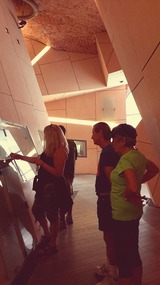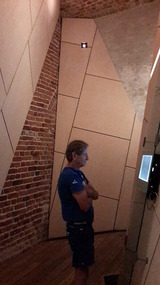We all gathered at our designated meeting place, the Central Train Station, at 10 o'clock to continue our exploration of the city and to find the Danish Jewish Museum. We wandered through cobbled stone streets and passed by beautiful historic and contemporary buildings before, finally, finding the museum.
The museum is located in the former Royal Boat House and the oldest section of the Royal Library that was built by King Christian IV in1598
. Renowned architect, Daniel Libeskind, was able to preserve the original building by intertwining the historic vaulted brick structure with new exhibition spaces and displays. The museum differs from other European museums because the Danish Jews were, by and large, saved from the Nazis by the efforts of their countrymen. This historical act of kindness or "mitzvah" is the guiding concept of the museum's design and is symbolized in its form, structure and light. Inside, there are no straight lines. Lilbeskind deliberately slanted the walls and sloped the wood-planked floor to make visitors feel they are standing on a boat; a reminder of the rocking seas thousands of Jews crossed as they fled Nazi-occupied Denmark for neutral Sweden. The walls are covered in Scandinavian light-colored birch plywood because of Denmark's Jewish history being more uplifting than most.
Experiencing this architectural masterpiece, recognized with an American Architect Award in 2005, was amazing. The exhibits, consisting of more than 1,500 three-dimensional objects and more than 3,500 photographs, in addition to numerous works of art, archival material, films, sound recordings and other materials, were beautifully displayed and incredibly moving.
Jutting out from the back wall of the historical structure that houses the Danish Jewish Museum is a modern waterfront extension to the Royal Danish Library referred to as the Black Diamond
. It was completed in 1999 as the first in a series of large-scale cultural buildings along Copenhagen's waterfront. To some degree, the Black Diamond mirrors the irregular lines of the museum in that its basic shape is a box that leans to the lefty, as seen from the harbor, as well as towards the water. At the same time, it expands slightly from the bottom and also from north to south giving it a distorted, prismatic shape. Apart from its function as a library, the building houses a number of other public facilities, including a 600-seat auditorium and the Queen's Hall, used for concerts, literary events, theatrical performances and conferences. There are also exhibition spaces, a bookshop and a restaurant and café where we enjoyed our lunch while marveling at the architecture of this stunning building.
After this day of sensory overload, we all headed back to our respective home exchanges to rest for a while before going to a potluck hosted by a friend of ours who used to own a condo in Manzanillo and is, now, living in Copenhagen. Her home was located a block from the Ocean in a suburb of Copenhagen that was very different from what we had been seeing in the city. The homes and gardens in the neighborhood were beautiful and the party was great fun, with good food and lots of interesting people from different parts of the world.
We finally headed home on the train after a very full and satisfying day and evening.
OUR ADVENTURE IN COPENHAGEN CONTINUES
Saturday, July 30, 2016
 Copenhagen, Zealand, Denmark
Copenhagen, Zealand, Denmark
Other Entries
-
1Layover in Atlanta en route to Baltimore
Jul 246 days prior Baltimore, United Statesphoto_camera2videocam 0comment 16
Baltimore, United Statesphoto_camera2videocam 0comment 16 -
2OUR BIG TRIP REALLY BEGINS!
Jul 273 days prior Baltimore, United Statesphoto_camera9videocam 0comment 6
Baltimore, United Statesphoto_camera9videocam 0comment 6 -
3FIRST FEW DAYS IN COPENHAGEN
Jul 282 days prior Copenhagen, Denmarkphoto_camera18videocam 0comment 6
Copenhagen, Denmarkphoto_camera18videocam 0comment 6 -
4OUR ADVENTURE IN COPENHAGEN CONTINUES
Jul 30 Copenhagen, Denmarkphoto_camera18videocam 0comment 4
Copenhagen, Denmarkphoto_camera18videocam 0comment 4 -
5ANOTHER PACKED FULL DAY
Jul 311 day later Copenhagen, Denmarkphoto_camera32videocam 0comment 5
Copenhagen, Denmarkphoto_camera32videocam 0comment 5 -
6OUR SMORREBROD COOKING LESSON
Aug 012 days later Copenhagen, Denmarkphoto_camera12videocam 0comment 6
Copenhagen, Denmarkphoto_camera12videocam 0comment 6 -
7HAMLET'S CASTLE
Aug 023 days later Copenhagen, Denmarkphoto_camera33videocam 0comment 6
Copenhagen, Denmarkphoto_camera33videocam 0comment 6 -
8FINAL DAY IN COPENHAGEN
Aug 034 days later Copenhagen, Denmarkphoto_camera41videocam 0comment 8
Copenhagen, Denmarkphoto_camera41videocam 0comment 8 -
9OUR ACCOMODATIONS WEREN'T QUITE WHAT WE EXPECTED
Aug 045 days later Prague, Czech Republicphoto_camera19videocam 0comment 4
Prague, Czech Republicphoto_camera19videocam 0comment 4 -
10MORE WALKING TOURS & EXPLORING
Aug 056 days later Prague, Czech Republicphoto_camera19videocam 0comment 3
Prague, Czech Republicphoto_camera19videocam 0comment 3 -
11WALKING TOUR OF PRAGUE CASTLE
Aug 067 days later Prague, Czech Republicphoto_camera22videocam 0comment 3
Prague, Czech Republicphoto_camera22videocam 0comment 3 -
12CRAFTS FAIR AND MUCHA MUSEUM
Aug 078 days later Prague, Czech Republicphoto_camera27videocam 0comment 6
Prague, Czech Republicphoto_camera27videocam 0comment 6 -
13JEWISH QUARTER WALKING TOUR
Aug 089 days later Prague, Czech Republicphoto_camera30videocam 0comment 2
Prague, Czech Republicphoto_camera30videocam 0comment 2 -
14EXCURSION TO CESKY KRUMLOV
Aug 0910 days later Prague, Czech Republicphoto_camera21videocam 0comment 2
Prague, Czech Republicphoto_camera21videocam 0comment 2 -
15CESKY KRUMLOV CASTLE & LAST SUPPER IN PRAGUE
Aug 0910 days later Prague, Czech Republicphoto_camera22videocam 0comment 9
Prague, Czech Republicphoto_camera22videocam 0comment 9 -
16A FEW FINAL PHOTOS
Aug 1011 days later Prague, Czech Republicphoto_camera19videocam 0comment 6
Prague, Czech Republicphoto_camera19videocam 0comment 6 -
17WE WELCOMED THE CHANGE OF PACE
Aug 1011 days later Horní Polubný, Czech Republicphoto_camera32videocam 0comment 4
Horní Polubný, Czech Republicphoto_camera32videocam 0comment 4 -
18THE GLASS FACTORY AND CROSSING INTO POLAND
Aug 1213 days later Horní Polubný, Czech Republicphoto_camera17videocam 0comment 0
Horní Polubný, Czech Republicphoto_camera17videocam 0comment 0 -
19POLAND AND BACK...FOR REAL
Aug 1314 days later Karpacz, Polandphoto_camera23videocam 0comment 7
Karpacz, Polandphoto_camera23videocam 0comment 7 -
20OFF ON ANOTHER DAY EXCURSION TO LIBEREC
Aug 1415 days later Liberec, Czech Republicphoto_camera33videocam 0comment 11
Liberec, Czech Republicphoto_camera33videocam 0comment 11 -
21VISITING THE ROCK CASTLES
Aug 1516 days later Malá Skála, Czech Republicphoto_camera40videocam 0comment 3
Malá Skála, Czech Republicphoto_camera40videocam 0comment 3 -
22GOODBYE TO HORNI POLUBNY AND OFF TO VENICE
Aug 1617 days later Prague, Czech Republicphoto_camera27videocam 0comment 0
Prague, Czech Republicphoto_camera27videocam 0comment 0
Comments
2025-05-23
Comment code: Ask author if the code is blank

 Copenhagen, Zealand, Denmark
Copenhagen, Zealand, Denmark





















Pastricks
2016-08-03
Great photo.....and interesting
Ronnie and Mary
2016-08-04
You are packing a lot in and learning so much from Interesing people.